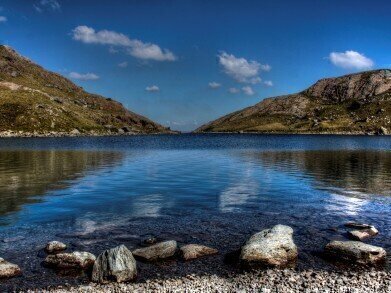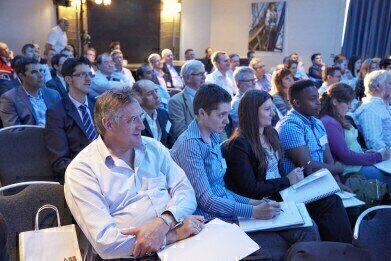-
 Damien Danieluk, 2013
Damien Danieluk, 2013 -

-

Water/Wastewater
Meaningful Measurement From Micro to Macro
Jul 19 2017
The water industry is increasingly being driven to deliver more for less by improving the efficiency of its operations, whilst at the same time environmental standards are becoming more stringent. There is also a move increasingly towards a ‘production’ factory approach to both water and wastewater treatment to drive efficiencies and work towards a circular model of resource use. Instrumentation for process control is therefore becoming more and more important. At the catchment scale, a growing population and agriculture is creating increasing pressure on water bodies. As the oft quoted adage says ‘you can’t control what you can’t measure’, so how can you achieve meaningful measurement of water at all of these different scales? This article will examine the development, use and uptake of water sensors from the micro to the macro scale.
The development of sensors and biosensors for water analysis is an innovative and rapidly expanding area for research. For example sensors utilising the potential of new materials such as graphene or carbon nanotubes using electrochemical or impedimetric measurement technologies show great promise. Another fascinating new material is boron doped diamond which is being used to develop a high performing pH electrode. However, new technologies do not always make it to market as viable products. Many new sensors which are closer to the market or already being used in products are based on optical methods such as the measurement of fluorescence. Fluorescence measurement integrated with flow cytometry for example allows the detection of bacteria in water which can even be monitored in real time, online. Another example utilises the measurement of excitation and emission spectra of water samples to detect multiple compounds simultaneously. Although ultra sensitive measurement technologies are under development there is always the hurdle of integrating sensing elements into a device which can measure real world samples in the field or online. In addition, new sensing technologies must be calibrated and validated to ensure they are accurate and reliable.
At the scale of treatment works (either water or wastewater), improvements in process control can increase treatment performance, reduce cost and better manage risk. The key role of monitoring instrumentation at the treatment works is to collect data on the current state of the works and convert this data to useful information to allow decisions to be made. The critical information required for decisions has to be selected in advance by understanding data requirements and installing the correct instrumentation. This further feeds the development of instrumentation including water sensor technology within the global industry as requirements are better understood. New sensors have been developed to monitor parameters at wastewater treatment works in real-time including BOD and metaldehyde to help meet environmental quality standards.
Instrumentation is also needed to monitor clean water or wastewater networks; for the distribution of potable water or the collection of wastewater respectively. The water industry needs to understand how effective its networks are and what quality of service they are delivering. Analysis of historic performance data is useful in identifying long-term deterioration and risk of service failure and for designing remediation measures. However, water companies increasingly aspire to use network information to understand what is happening now, to deliver insights into likely service levels over the next few hours and to drive real-time interventions to deliver great service in the most efficient way.
At the catchment scale, the health of water bodies can only be assessed by monitoring both water quality (chemical constituents) and quantity (flow and/or level). Chemical analysis of spot samples provides much useful information, but does not readily provide a picture of daily fluctuations – for that automatic sensors are needed. Recent years have seen some significant improvements in sensor technology with greater precision for traditional sensors and additional parameters form new techniques such as the fluorescence method mentioned above. Flow measurement has advanced with non-contact systems and boat mounted acoustic Doppler correlation devices to compliment the network of level sensors and rain gauges. There have also been impressive advances in remote sensing using aircraft based LIDAR systems and satellites with improved resolution capable of observing changes in water bodies and catchments, even down to the crops being grown. Again, advances in IT, data analytics and communication have enabled some catchments to be monitored in near real-time.
In the era of the Internet of Things, smart sensing and remote monitoring will doubtless be the future. Integrating multiple sensing technologies to monitor either drinking water or wastewater treatment works and connecting sensor networks to the cloud will allow a step change in data analytics. The aim is that operators will receive early warnings of impending problems, enabling a more proactive response and reducing costs, therefore enhancing efficiencies.
However, despite ‘real-time data’ and ‘smart’ water networks having been discussed for at least 10 years the actual take up of sensing technologies for water networks in particular has been slow. Various barriers have held up sensing of networks including the availability of instruments to deliver real-time information at an affordable cost of ownership; capability of systems to store, manage and analyse vast quantities of data and to deliver actionable insights in real-time; and an unclear business case for network scale monitoring. The cost of sensors for networks is decreasing: the size and cost of energy storage is reducing with advancements in battery technology alongside improvements in communication technology and the realisation that sometimes crude measurements are sufficient rather than lab-quality measurements. Advances in information technology can now handle big data securely, with storage in the ‘cloud’, machine learning (artificial intelligence) offering automatic recognition of patterns and anomalies, powerful and user-friendly visualisation tools and automated network control systems delivering cost and quality benefits. To some extent as affordable sensors for networks and data processing solutions are delivered the benefits will be seen and the business case for investment will become clearer. However, there still remains the most challenging barrier of an extensive ageing infrastructure in the water industry which is difficult to access making retrofitting of sensors difficult. Also physical intervention is constrained by resource availability and practicalities, if real-time action is not possible then the value of real-time information reduces.
This is an exciting time to be involved with water metrology and the above topics will be explored in more detail at the Sensing in Water Conference, 27-28 September 2017, at the Nottingham Belfry. The conference and exhibition provide an ideal opportunity for great networking to review, develop and promote the latest technologies.
Rosa Richards is Programme Manager of the Sensors for Water Interest Group.
Acknowledgements: This article includes contributions from: Richard Luxton, Director at the Institute for Biosensing Technology, at the University of the West of England; Oliver Grievson, Flow Compliance & Regulatory Efficiency Manager, Anglian Water; Chris Jones, R&D Manager, Northumbrian Water; and Andrew Chappell, Technical Advisor specialising in water monitoring instruments, Environment Agency.
Digital Edition
IET 34.2 March 2024
April 2024
Gas Detection - Biogas batch fermentation system for laboratory use with automatic gas analysis in real time Water/Wastewater - Upcycling sensors for sustainable nature management - Prist...
View all digital editions
Events
Apr 30 2024 Melbourne, Australia
Apr 30 2024 Birmingham, UK
May 03 2024 Seoul, South Korea
May 05 2024 Seville, Spain
May 06 2024 Minneapolis, MN, USA

















